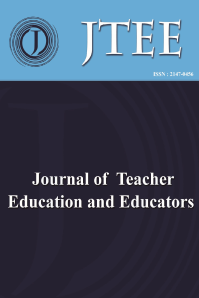Sosyokültürel Bir Bakış Açısıyla İki Dilli / İDİ Öğretmen Adaylarının Kimliği
Öğretmen adaylarının eğitimi, iki dilli eğitim ve İDİ eğitimi, kimlik
Pre-service Bilingual/ESL Teacher Identity from a Sociocultural Perspective
___
- Amin, N. (1997). Race and the identity of the nonnative ESL teacher. TESOL Quar- terly, 31(3), 580-583.
- Arva, V., & Medgyes, P. (2000). Natives and non-natives teachers in the classroom. System, 28(3), 355-372.
- Benke, E., & Medgyes, P. (2005). Differences in teaching behavior between native and non-native teachers: As seen by the learners. In E. Liurda (Ed.), Non-native language teachers: Perceptions, challenges, and contributions to the profession (pp. 195-215). New York: Springer.
- Bogdan, R. C., & Biklen, S. K. (1982). Qualitative research for education: An intro- duction to theory and methods. (Third Edition). Ally & Bacon: Boston
- Bogdan, R. C & Biklen, S. K. (2003). Qualitative research for education: An introduc- tion to theories and methods (4th ed.). New York: Pearson Education group. (pp. 110-120).
- Bullough, R.V., Jr. (2005). Being and becoming a mentor: School-based teacher edu- cators and teacher educator identity. Teaching and Teacher Education. 21, 143-155.
- Burns, A., & Richards, J. (Eds.). (2009 ). The Cambridge guide to second language teacher education. New York Cambridge University Press.
- Bonk, C. J., & Cunningham, D. J. (1998). Searching for learner-centered, constructi- vist, and sociocultural components of collaborative educational learning tools. In C. J. Bonk & K. S. King (Eds.), Electronic collaborators: Learner-centered tech- nologies for literacy, apprenticeship, and discourse (pp. 25–50). Mahwah, NJ: Lawrence Erlbaum Associates.
- Canagarajah, S. (1999). Interrogating the „native speaker fallacy‟: non-linguistic roots, non-pedagogical results. In G. Braine (Ed.), Non-native educators in English lan- guage teaching (pp. 77-92). Mahwah, NJ: Erlbaum.
- Chiang, M. (2008). Effects of fieldwork experience on empowering prospective fore- ign language teachers. Teaching and Teacher Education, 24(5), 1270-1287.
- Chun, S. Y. (2014). EFL learners' beliefs about native and non-native English- speaking teachers: perceived strengths, weaknesses, and preferences. TESOL Quarterly, 35(6), 563-579.
- Darling-Hammond, L., Chung, R., & Frelow, F. (2002). Variation in teacher prepara- tion: How well do different pathways prepare teachers to teach? Journal of Teacher Education, 53(4), 286-302.
- Ellis, E. (2004). The invisible multilingual teacher: The contribution of language background to Australian ESL teachers' professional knowledge and belief. The International Journal of Multilingualism, 1(2), 90-108.
- Erickson, F. (1986). Qualitative methods in research on teaching. In M. C. Wittrock (Ed.), Handbook of research on teaching. New York: Macmillan.
- Farrell, T. (2007). Failing the practicum: Narrowing the gap between expectations and reality with reflective practice. TESOL Quarterly, 41(1), 193-201.
- Fotovatian, S. (2010). Surviving as an English teacher in the West: A case study of Iranian English teachers in Australia. TESL-EJ. 13(4). 1-10.
- Galindo, R. (1996). Reframing the past in the present: Chicana teacher role identity as a bridging identity. Education & Urban Society, 29(1), 85-102.
- Gee, J. P. (2008). Social linguistics and literacies: Ideology in discourses (3rd ed.). New York, NY: Routledge.
- Haneda, M. (2006). Classroom as communities of practice: A reevaluation. TESOL Quarterly, 40(4), 807-817.
- Johnson, K. E. (2006). The sociocultural turn and its challenges for second language teacher education. TESOL Quarterly, 40(1), 235-257.
- Mahboob, A., Uhrig, K., Hartford, B. & Newman, K. (2004). Children of a lesser Eng- lish: Nonnative English speakers as ESL teachers in English language programs in the United States. In L. D. Kamhi-Stein (Ed.), The state of the non-native teachers in the United States. Michigan: University of Michigan Press.
- Miller, J. (2009). Teacher identity. In A. Burns & J. Richards (Eds.), The Cambridge guide to second language teacher education (pp. 172-181). Cambridge: Cambrid- ge University Press.
- Norton, B. (1995). Social identity, investment, and language learning. TESOL Quar- terly, 29(1), 9-31.
- Norton, B. (1997). Language, identity, and the ownership of English. TESOL Quar- terly, 31(3), 409-429.
- Norton, B. (2000). Identity and language learning: Gender, ethnicity and educational change. Harlow, England: Pearson Education Limited.
- Numrich, C. (1996). On becoming a language teacher: Insights from diary studies. TESOL Quarterly, 30(1), 131-153.
- Orem, R. (2001). Journal writing in adult ESL: Improving practice through reflective writing. New Directions for Adult and Continuing Education, 90, 69-77.
- Pavlenko, A. (2003). “I never knew I was bilingual”: Reimagining teacher identities in TESOL. Journal of Language, Identity, and Education, 2(4), 251–268.
- Samimy, K. K., & Brutt-Griffler, J. (1999). To be a native or non-native speaker: Per- ceptions of "non-native" students in a graduate TESOL program. In G. Braine (Ed.), Non-native educators in English language teaching. Mahwah, NJ: Erl- baum.
- Thomas, J. (1999). Voice from the periphery: Non-native teachers and issues of credi- bility. In G. Braine (Ed.), Non-native educators in English language teaching Mahwah, NJ: Erlbaum.
- Todd, W., & Punjaporn, P. (2009). Implicit attitudes towards native and non-native speaker teachers. System, 37(1), 23-33.
- Tsui, A. (2007). Complexities of identity formation: A narrative inquiry of an EFL teacher. TESOL Quarterly, 41(4), 657–680.
- Urrieta, L. (2007). Figured worlds and education: an introduction to the special issue. The Urban Review, 39(2), 107-116.
- Varghese, M., Morgan, B., Johnston, B., & Johnson, K. (2005). Theorizing language teacher identity: Three perspectives and beyond. Journal of Language, Identity, and Education, 4(1), 21–44.
- Wenger, E. (1998). Communities of practice: Learning, meaning, and identity. New York: Cambridge University Press.
- ISSN: 2147-0456
- Başlangıç: 2012
- Yayıncı: İlknur GÖKÇE
İngilizce Yeterlilik Endeksi Verileri Işığında Türkiye’nin Yeri
Bir Öğretmenin Eğitim Programının Yapılanması: Teknolojik Uyarlama İçin Bir Strateji
ángela María Alfaro ESCOBAR, Marcela Georgina Gómez ZERMEÑO, Lorena Alemán De La GARZA
Ortaokul Öğrencilerinin ve Öğretmenlerinin Öğrenme ve Öğ- retmeye İlişkin Metaforik Algıları
Özlem URAL, İbrahim AYDEMİR, Asiye TOKER-GÖKÇE, Zehra ÖZTOPRAK-KAVAK
Yunan Okul Müdürlerinin Öğretmenlerin Performanslarını Değer- lendirmeye Yönelik Yeterlik İnançları
Kalliope KALTSONOUDİ, Anastasia Athanasoula-Reppa
Sosyokültürel Bir Bakış Açısıyla İki Dilli / İDİ Öğretmen Adaylarının Kimliği
